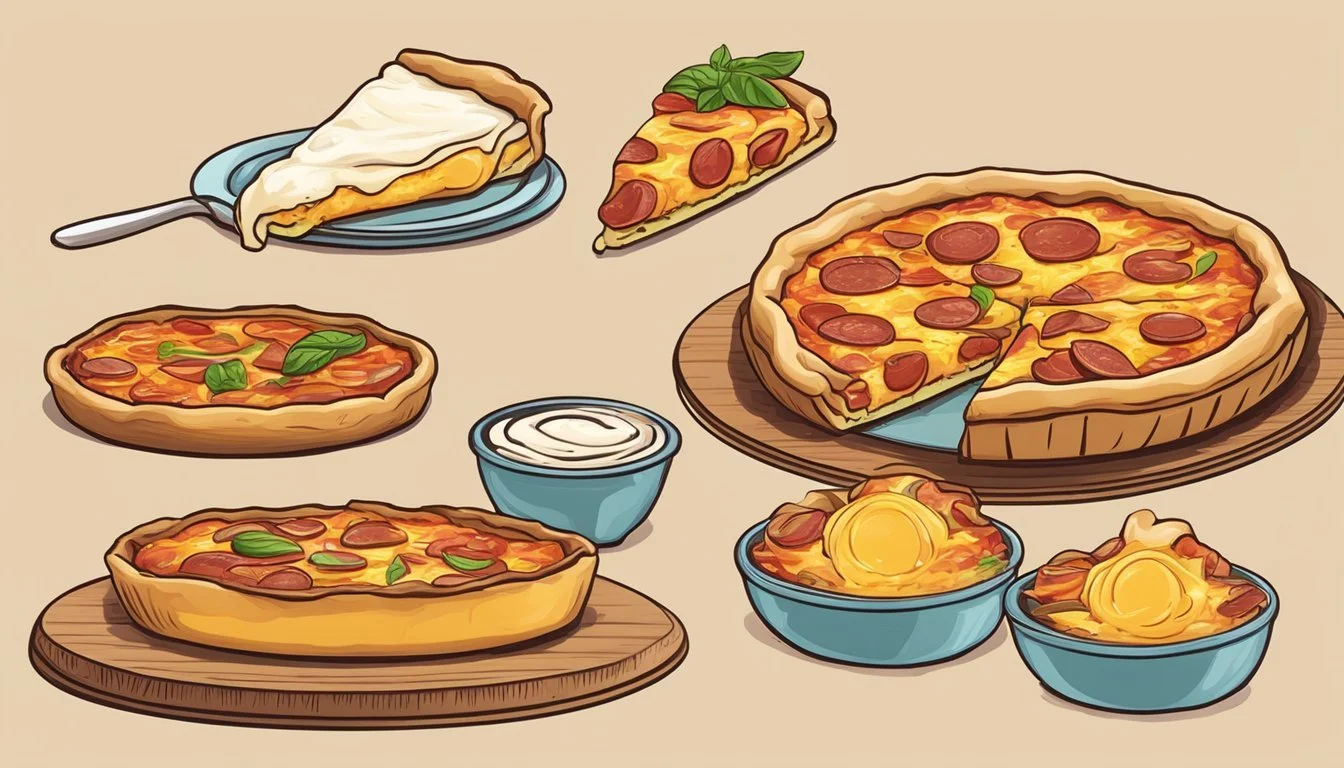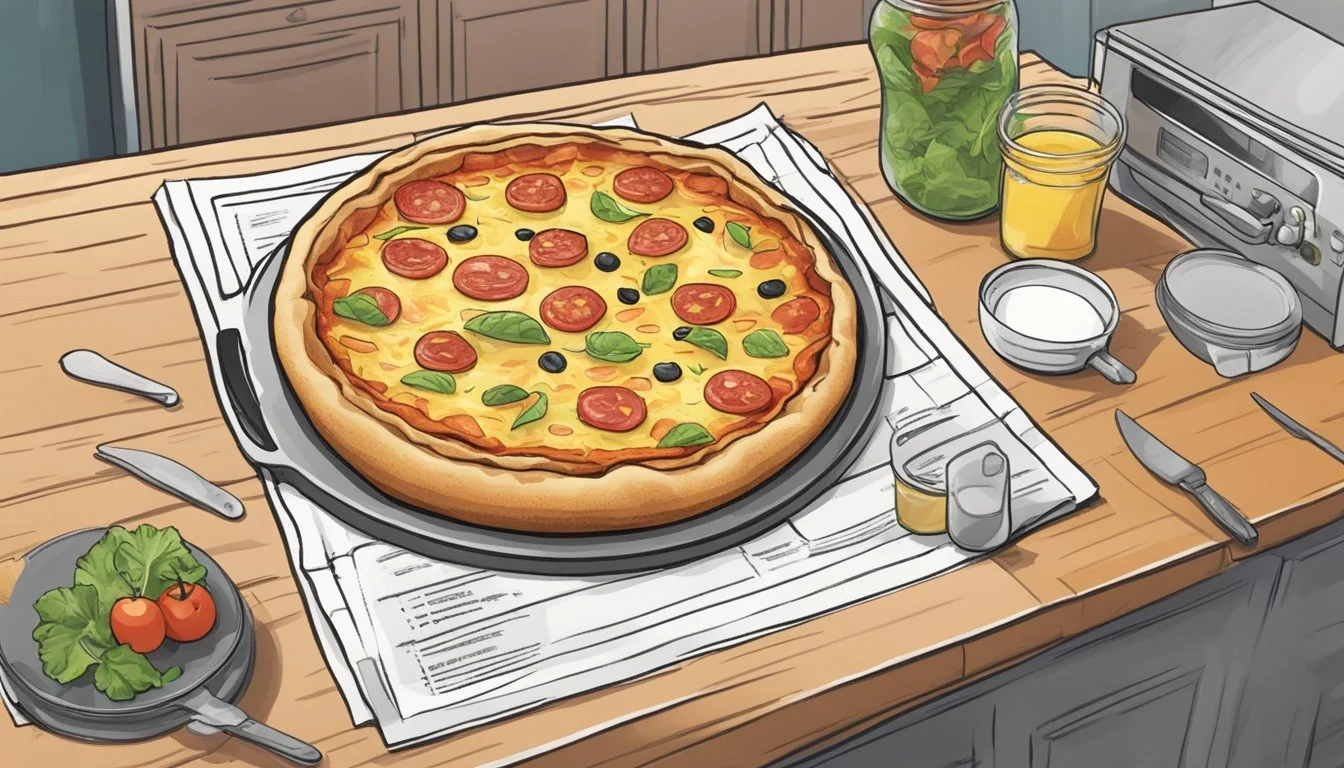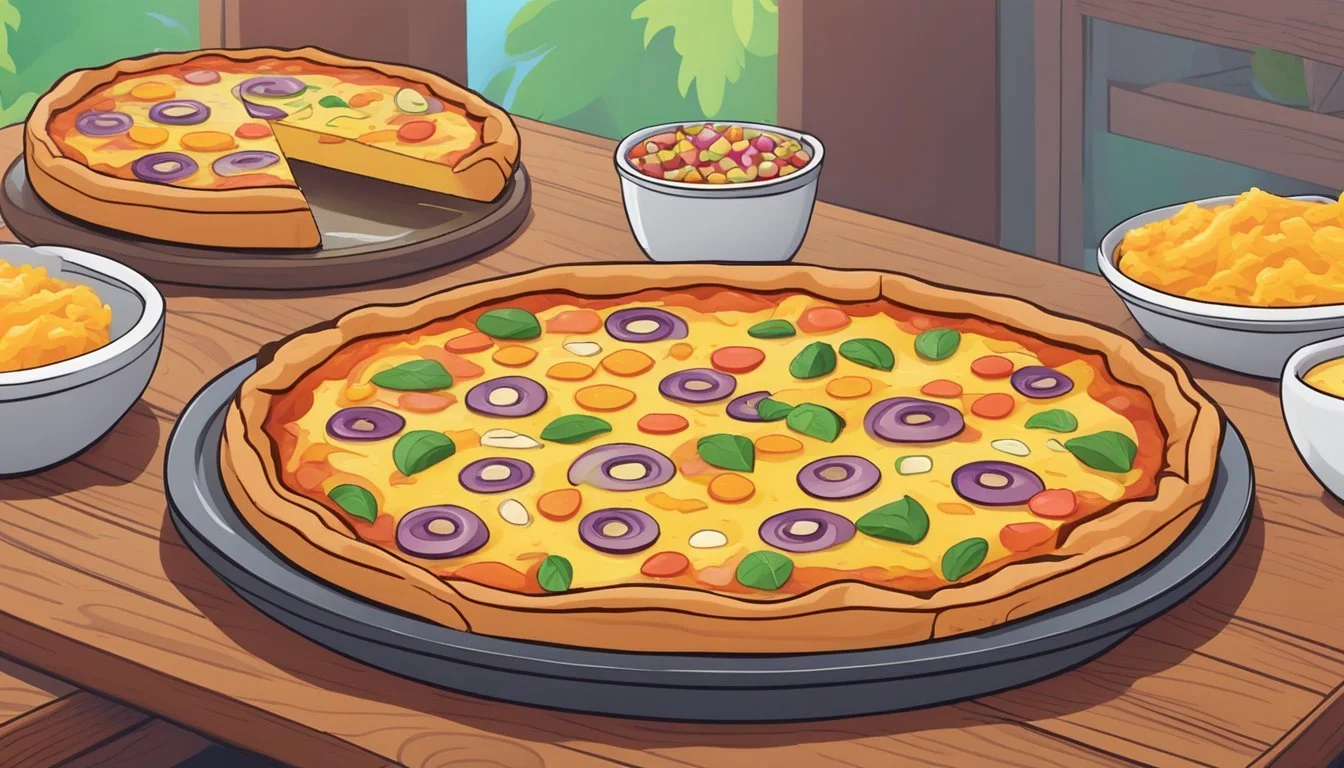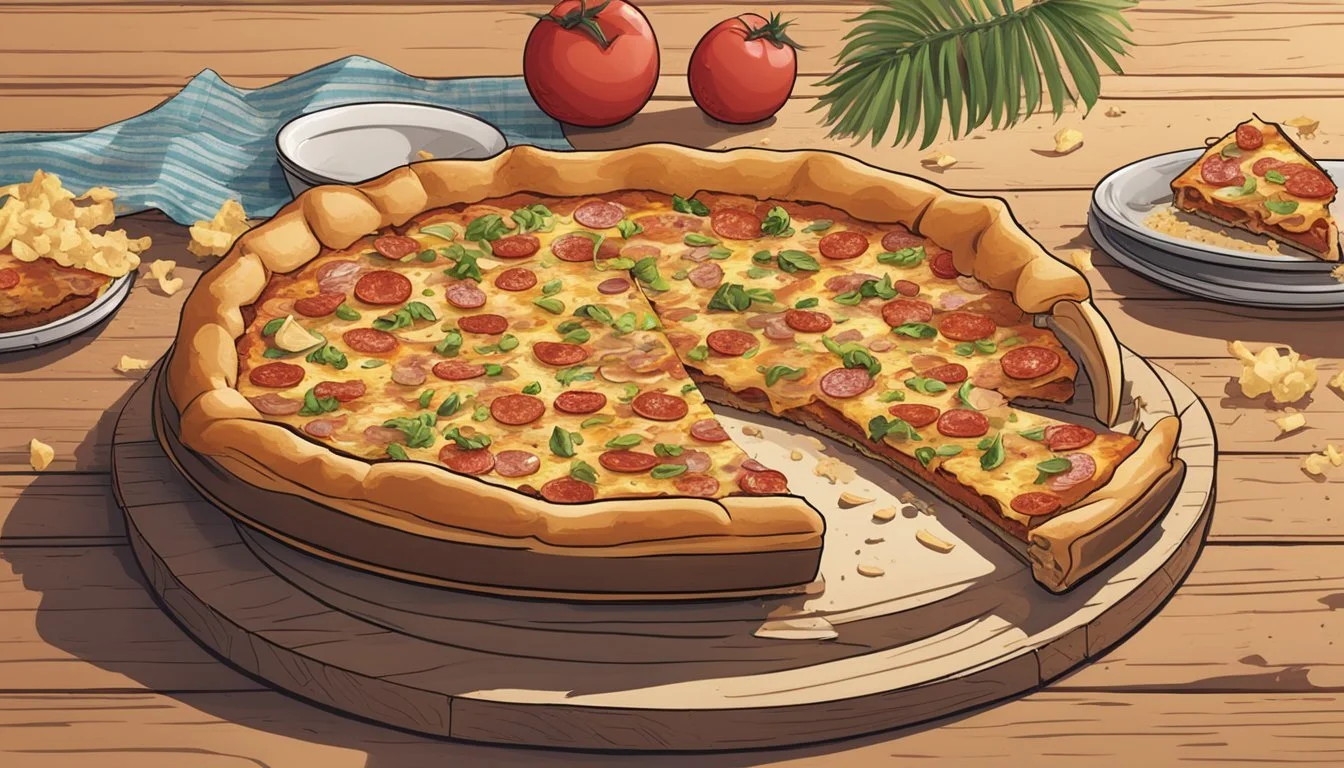How Long Does Deep Dish Hawaiian Pizza Last?
Storage Tips and Shelf Life
Deep dish Hawaiian pizza is a delicious treat that combines a rich, thick crust with savory ham and sweet pineapple toppings. When you have leftovers, it's important to know how long this pizza will last to ensure it's safe and tasty to eat. Deep dish Hawaiian pizza can typically last in the refrigerator for up to 3-4 days when stored properly.
Maintaining the right storage conditions is crucial for the pizza's longevity. Store it in an airtight container or wrap it tightly in plastic wrap to prevent it from drying out and absorbing other flavors from the fridge. If you need to keep it longer, freezing the pizza will extend its lifespan to about 1-2 months.
Understanding how to store your deep dish Hawaiian pizza helps you enjoy every last bite without worry. With these tips, you can relish your favorite pizza even days after it was freshly baked.
The Basics of Deep Dish Hawaiian Pizza
Deep dish Hawaiian pizza combines the rich textures of deep dish pizza with the sweet and savory flavors of a Hawaiian pizza. This pizza features a thick crust, plentiful toppings of pineapple and ham, and generous layers of cheese and sauce.
What Is Deep Dish Hawaiian Pizza?
Deep dish Hawaiian pizza is a type of pizza known for its thick, buttery crust. Unlike traditional thin-crust pizzas, deep dish pizza supports a generous amount of toppings and cheese. Hawaiian pizza itself typically includes pineapple and ham, creating a unique balance of sweet and savory flavors. Combining these elements with a deep dish crust results in a hearty, satisfying meal.
Key Ingredients for Hawaiian Pizza
The primary ingredients for a Hawaiian pizza are pineapple, ham, and mozzarella cheese. Pineapple adds a sweet and slightly tangy contrast to the savory ham. The ham, usually Canadian bacon, provides a salty counterbalance to the pineapple. Mozzarella cheese binds these ingredients together and ensures a creamy, melted texture in each bite. Optional ingredients can include pizza sauce to cover the dough and additional toppings like bell peppers or onions for extra flavor.
Deep Dish Pizza Dough Essentials
Creating the perfect deep dish pizza dough involves a few critical steps. Flour serves as the base; all-purpose flour is commonly used for a balanced texture. The yeast mixture, often combined with warm water and oil, is critical for fermentation, giving the dough its rise and fluffy interior. It’s essential to let the dough sit and rise, covered, for at least 30 minutes to achieve the desired thickness. A cast iron skillet or deep pizza pan will help form the dough into a crust that can hold substantial toppings without becoming soggy.
Preparation and Cooking Techniques
Making a deep dish Hawaiian pizza involves careful preparation of the dough, selecting the right baking method, and using ideal tips for creating a homemade pizza crust.
Assembling Your Hawaiian Pizza
To start, prepare the homemade pizza dough by mixing yeast, water, and oil. Use a stand mixer with a dough attachment for best results. Allow the dough to rest covered for about 30 minutes to rise.
Stretch and press the dough into a 12-inch pizza pan or cast iron skillet, ensuring it goes up the sides slightly. Apply a generous layer of pizza sauce, followed by cheese and Hawaiian toppings such as ham and pineapple.
Ensure even distribution of toppings to achieve a well-balanced flavor. Adding a light sprinkling of cornmeal on the pan can help prevent sticking.
Baking Methods for Deep Dish Pizza
For even baking, preheat the oven to 425 degrees Fahrenheit. If possible, use a preheated baking stone or pizza steel to facilitate an evenly cooked crust. Bake the prepared pizza in a cast iron skillet or pizza pan for 8-12 minutes, or until the crust becomes golden brown and the cheese melts.
For a more traditional texture, allow the dough to rise in the skillet before adding toppings, letting it double in size. This can be done by covering and setting it aside in a warm place for about 30-45 minutes. Adjust timing based on how thick and fluffy you want your crust.
Homemade Pizza Crust Tips
The key to a successful homemade pizza crust lies in using quality ingredients and following proper kneading and resting techniques. Knead the dough on a floured surface until smooth and elastic, typically about 4 minutes. Resting the dough for 10 minutes before stretching can help develop the right texture.
Press the dough gently to fill the pizza pan, ensuring no thin spots which could lead to uneven baking. Adding olive oil to the baking surface can enhance the crust's taste and texture. If you prefer, brush a light layer of olive oil over the edges of the crust for extra flavor and crispiness.
Storage Guidelines for Hawaiian Pizza
Proper storage is crucial to maintain the freshness and safety of your Hawaiian pizza. Factors like temperature control, packaging, and timeframe are key to prolonging its shelf life.
Refrigeration Best Practices
Store Hawaiian pizza in the refrigerator at or below 40°F (4°C). Ensure the pizza is wrapped tightly in plastic wrap or aluminum foil to prevent it from drying out and absorbing odors. Leftovers should be placed in airtight containers to maintain moisture and flavor.
Tip: Use a layer of wax paper between slices before wrapping to avoid sticking. When stored correctly, leftovers can last up to 4 days.
Freezing and Thawing Your Pizza
For longer storage, freezing is an effective option. Wrap the pizza tightly in plastic wrap, followed by a layer of aluminum foil to prevent freezer burn. Store at or below 0°F (-18°C). For convenience, you may also place wrapped slices in a freezer bag.
To thaw, move the frozen pizza to the refrigerator to thaw overnight. This gradual defrosting helps maintain the texture and flavor. For a quicker option, let it sit at room temperature for 1-2 hours.
Food Safety Considerations
Food safety is paramount when storing pizza. Bacteria grow quickly between 40°F and 140°F, so ensure pizza doesn’t stay at room temperature for more than 2 hours. If in doubt, discard any pizza that has been left out longer to avoid risk of foodborne illness.
Key: Always check for signs of spoilage like unusual odor, appearance, or taste, and discard if necessary. When reheating, ensure the internal temperature reaches 165°F (74°C) to eliminate harmful bacteria.
Proper storage practices will ensure your Hawaiian pizza remains safe to eat while retaining its delicious flavor and texture.
Maximizing the Shelf Life
To ensure deep dish Hawaiian pizza remains fresh and safe to eat, it is critical to store it correctly. Consider optimal conditions for refrigeration and be aware of factors that can lead to spoilage. Here are some guidelines to maximize the shelf life of your deep dish Hawaiian pizza.
Ideal Conditions for Preservation
Temperature: Store the pizza in a fridge set below 40°F (4°C). This slows bacterial growth that can lead to food spoilage.
Storage Method: Use airtight containers or tightly wrap the pizza in plastic wrap. This preserves moisture and prevents refrigerator odors from affecting the pizza's taste.
Layering Technique: Store slices in a single layer on a tray or plate. Avoid stacking slices, as this can lead to soggy crusts.
Ingredients: Pay extra attention to the pineapple chunks and fresh mozzarella. Their high moisture content can lead to quicker spoilage compared to other ingredients like cooked ham.
Avoiding Common Spoilage Factors
Timely Refrigeration: Refrigerate the pizza promptly, ideally within two hours of baking to prevent the growth of harmful bacteria.
Contamination Prevention: Use clean utensils when handling the pizza. Avoid cross-contamination from other foods in the fridge.
Regular Checks: Inspect the pizza for any signs of mold, off smells, or changes in texture. If any of these are present, it's safest to discard the pizza.
Cross Contamination Control: Keep meat-based toppings and other highly perishable items separate if storing multiple foods in the fridge. This ensures that any spoilage in one doesn't affect others.
Estimating the Duration of Freshness
Typical Shelf Life: Hawaiian pizza can generally be stored in the fridge for 3-4 days. Beyond this, the risk of bacterial growth increases, making the pizza unsafe to eat.
Visual and Smell Inspection: Look for signs of spoilage such as discoloration, off odors, or a slimy texture. These are indicators that the pizza should not be consumed.
Reheating Best Practices: When reheating, ensure the pizza reaches an internal temperature of 165°F (74°C). This kills any potential bacteria that may have grown during storage.
By following these practices, you can enjoy your deep dish Hawaiian pizza for several days without compromising its quality or safety.
Reheating and Serving Leftover Pizza
Enjoying leftover deep dish Hawaiian pizza involves knowing the best ways to reheat it for optimal flavor and texture. Additionally, there are creative methods to repurpose and enjoy it.
Best Practices for Reheating
To reheat deep dish pizza, preheating the oven to 350°F ensures the crust doesn't burn. Place slices on a greased, parchment- or foil-lined baking sheet for even heating. Bake for 15-20 minutes, depending on thickness, and consider lightly misting with water to maintain moisture.
Using an air fryer can provide a crispy crust. Set it to 375°F and heat slices for 5-7 minutes. Microwaving is quickest but may make the crust soggy. Use a microwave-safe plate, cover the pizza with a damp paper towel, and heat on high for about 1-2 minutes.
Creative Ways to Enjoy Day-Old Pizza
Transforming leftover pizza into breakfast pizza is simple. Heat in the oven, then top with a fried or scrambled egg. For a savory twist, add a sprinkle of fresh herbs.
Turn pizza into a unique dish by making pizza croutons. Cut slices into cubes, bake at 375°F until crispy, and use them to top salads. Alternatively, make pizza rolls by rolling slices and baking until the crust is golden.
Another idea is to integrate leftover slices into a pizza casserole. Layer pieces in a baking dish with extra cheese and toppings, then bake until everything is melted and delicious.
By exploring these methods, leftover deep dish Hawaiian pizza can become a delightful new meal.
Enhancing Your Pizza Experience
For a memorable pizza night, consider refining your Hawaiian pizza with complementary pairings, fresh herbs, and exciting variations. These strategies can elevate both flavor and presentation, making each bite delightful.
Pairing Suggestions and Side Dishes
Enhance your pizza experience by pairing Hawaiian pizza with side dishes that complement its unique flavors. Consider fresh salads with light citrus vinaigrettes to balance the sweetness of pineapple on pizza.
For a heartier meal, serve with garlic bread or cheesy breadsticks. Dips like marinara, ranch, or a tangy barbecue sauce work well with Hawaiian pizza's ingredients.
Adding a glass of chilled white wine or a fruity beer can also enhance the flavors of the pizza. The contrast between the pizza and the drinks provides a refreshing balance to the savory and sweet mix.
Garnishing with Herbs and Spices
Fresh herbs and spices can significantly enhance the aroma and taste of your Hawaiian pizza. Cilantro and parsley are excellent choices for a fresh, herbal note.
Sprinkle chopped cilantro or parsley over the hot pizza for a burst of color and flavor. Red pepper flakes can be used to add a bit of heat, balancing the sweetness of the pineapple.
Garlic powder and oregano are classic pizza spices that can deepen the complexity of the flavors. Don't hesitate to experiment with other herbs like basil or thyme to suit your personal taste.
Exploring Variations of Hawaiian Pizza
Hawaiian pizza is versatile, allowing for exciting variations. BBQ Chicken Pizza can be informed with elements of Hawaiian flavors, substituting Canadian bacon with grilled chicken and adding a barbecue sauce base.
Consider a Pesto Pizza with pineapple, where the traditional tomato sauce is replaced with basil pesto, and topped with Canadian bacon or even pepperoni for a twist.
For a spicier option, try adding jalapeños along with the pineapple and bacon. These variations provide creative ways to enjoy different aspects of Hawaiian pizza while keeping the core flavor profile intact.
Additional Tips and Tricks
Making a perfect deep dish Hawaiian pizza requires attention to detail, particularly when preparing the dough, using leftovers creatively, and making the cooking process enjoyable for everyone involved.
Making Dough with a Stand Mixer
For a plush, airy crust, use a stand mixer to knead the dough. Start by combining the flour, yeast, water, and a touch of oil in the mixer. Use the dough hook attachment on low speed to mix until the ingredients are combined. Increase the speed and knead for about 6-8 minutes until the dough is smooth.
Ensure the dough achieves the right consistency by adding a bit of water or flour as needed. Let it rest in a warm place for about 30 minutes, allowing it to rise. This method can save time and effort compared to manual kneading and ensures a well-developed gluten structure for that perfect, chewy crust.
Utilizing Leftovers in Creative Ways
Leftover deep dish Hawaiian pizza can be repurposed creatively. Pineapple tidbits and ham can be chopped and added to a breakfast scramble or salad. Bacon grease from the pizza can be reused for frying potatoes or vegetables, giving them a smoky flavor.
Cut pizza slices into smaller pieces and serve as a quick snack or appetizer. Another idea is making pizza croutons: dry out leftover slices in the oven, then cut into cubes for a unique salad topping. These tips minimize waste and keep meals exciting.
Pizza Making as a Social Activity
Pizza making can be a fun and interactive event. Invite friends or family over and involve everyone in the process, from rolling out the dough to adding toppings like canned pineapple and bacon. Set up a topping station and let each person build their own pizza, creating a personalized experience.
Share recipe ideas or photos on social media platforms like Facebook or Instagram to inspire others and document the fun. This communal activity not only results in delicious food but also fosters a sense of connection and creativity among participants.







